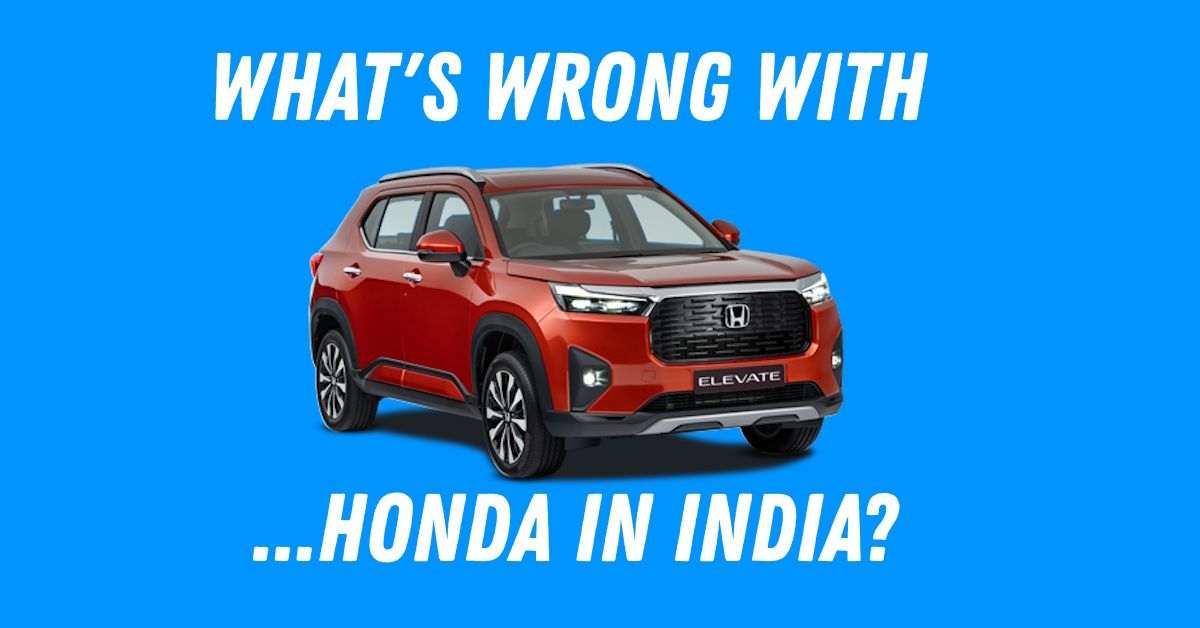What Is Wrong With Honda In India? Can Things Be Turned Around?


Once hailed as a benchmark for engineering finesse, Honda now finds itself slipping into irrelevance in India’s hyper-competitive automotive market. April 2025 sales data paints a grim picture. Honda sold just 4,400 units, a far cry from segment leaders like Maruti Suzuki, Hyundai, Tata Motors, and Mahindra, each of whom comfortably crossed the 40,000-unit mark. Even newer entrants like Kia and Volkswagen have surged ahead, leaving Honda in a shrinking space with dwindling mindshare and market share.
Honda’s current crisis did not arrive overnight. It is the result of strategic miscalculations, product delays, and a growing disconnect with Indian buyers. For a brand that once had the wow factor, whether it was the iconic Honda City with VTEC bragging rights or the ultra-stylish Civic and CR-V, today’s portfolio feels uninspired and dated.
Eerhaps the most glaring issue is Honda’s prolonged over-reliance on sedans. The City and Amaze continue to make up a bulk of the company’s sales, even though the sedan segment has been hollowed out by the rise of SUVs. While rivals pivoted early towards SUVs, Honda clung to its sedans, losing time and relevance. What was once a premium urban choice now feels like a relic from a bygone era.
Honda did try to crack the SUV code, but its efforts were rarely full-blooded. The BR-V and WR-V lacked the aggression, flair, and performance that Indian buyers seek in SUVs. Even the Elevate, which arrived late to the party in 2023, came across as a conservative effort. Despite a decent design and competitive pricing, it skipped crucial drivetrain options. There was no diesel, no turbo-petrol, and no hybrid. This is especially baffling considering the City already has both a hybrid and a turbo variant in other global markets.
In the early 2000s, owning a Honda was aspirational. The brand stood for premium quality, great engines, and superior driving dynamics. Today, those attributes have either become commoditised or are being offered more compellingly by rivals. Hyundai and Kia offer feature-packed interiors and striking designs. Mahindra provides muscular, tech-laden SUVs. Even Toyota’s badge value and hybrid technology have made a comeback. Honda, in contrast, offers no standout value proposition. There are no segment-first features, no thrilling powertrains, and no segment-disrupting pricing.
There has also been a big shift in what Indian buyers value today. Earlier, Honda could rely on its reputation for reliability and fuel efficiency as a key differentiator. But the BS6 era and global component sourcing have levelled that playing field. Today, all major brands offer good enough reliability. Buyers are now chasing road presence, technology, safety features, and performance. These are areas where Honda neither leads nor competes aggressively.
Behind the scenes, dealer sentiment is also a red flag. A few Honda dealers have shut shop or diversified into other brands. Low footfalls, thin product pipelines, and uninspiring updates have made Honda showrooms quiet places. This lack of ground-level enthusiasm further hurts the brand’s ability to revive sales organically.
Honda is not giving up just yet. It has laid out a roadmap of upcoming products that could stem the slide, if not reverse it altogether.
Honda plans to launch an all-electric version of the Elevate. This would mark the brand’s debut in India’s EV space, where competition is intensifying. Tata Motors, Mahindra, MG, and Hyundai have already taken early leads. For Honda to succeed here, it needs to offer real range, fast charging, and sharp pricing. None of this will be easy.
Perhaps the most obvious gap in Honda’s India portfolio is a hybrid SUV. Given that the City e:HEV already exists, slotting that hybrid system into the Elevate could offer a unique alternative to buyers who want fuel efficiency but are wary of EV infrastructure. If priced well, it could appeal to fleet and urban buyers alike.
Globally, Honda has a well-regarded lineup of crossovers like the ZR-V and HR-V. These are more premium and urban-focused than the Elevate and could help the brand capture the fast-growing Rs 15 to 25 lakh SUV segment. However, these models would need heavy localisation and sharp pricing to work in India.
Another hole in Honda’s lineup is a sub-4 metre SUV. With models like Tata Punch, Hyundai Exter, Maruti Fronx and Brezza performing strongly, Honda’s absence here is hurting its volumes. A product in this space is reportedly under consideration but not yet confirmed.
Ultimately, no single car will revive Honda’s fortunes in India. What is needed is a complete rethink of its India strategy. The brand must localise more aggressively, introduce competitive drivetrain options like turbo-petrols and hybrids, and build back the aspirational appeal that once defined it. It must also win back younger urban buyers, many of whom have no emotional connect with the Honda badge today.
At this point, Honda is dangerously close to irrelevance in India. With just a sliver of market share and a thinning product line, it is playing catch-up in a race where others have already surged ahead. The Elevate gave it a brief sales bump, but without deeper investment into innovation and differentiation, the brand risks becoming a fringe player in what was once one of its strongest global markets.
Honda still has brand recall. It still has engineering depth. What it lacks is urgency. And in a market as dynamic as India, that absence may cost it everything.